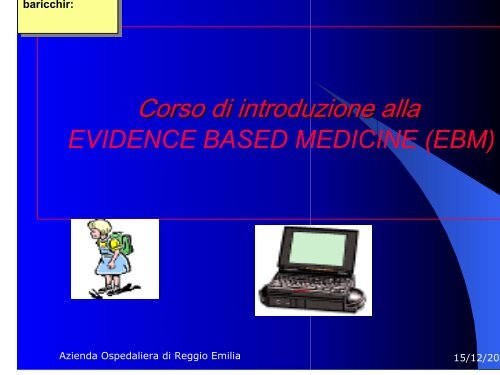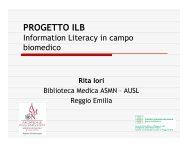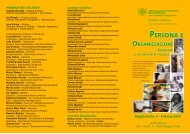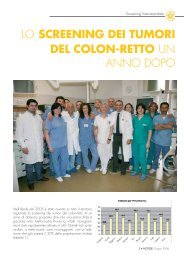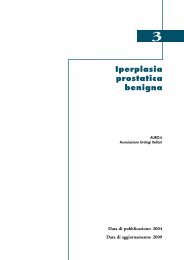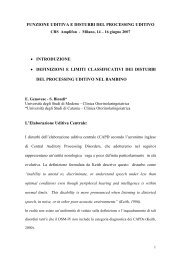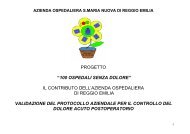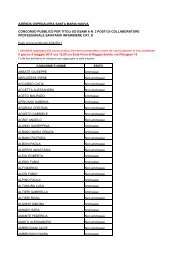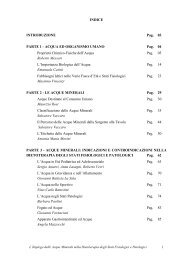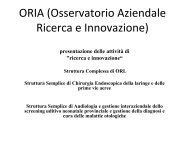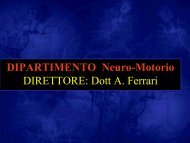Corso di introduzione all'Evidence Based ... - Biblioteca Medica
Corso di introduzione all'Evidence Based ... - Biblioteca Medica
Corso di introduzione all'Evidence Based ... - Biblioteca Medica
You also want an ePaper? Increase the reach of your titles
YUMPU automatically turns print PDFs into web optimized ePapers that Google loves.
aricchir: baricchir:<br />
<strong>Corso</strong> <strong>di</strong> <strong>introduzione</strong> alla<br />
EVIDENCE BASED MEDICINE (EBM)<br />
Azienda Ospedaliera <strong>di</strong> Reggio Emilia<br />
15/12/200
Azienda Ospedaliera <strong>di</strong> Reggio Emilia<br />
15/12/200
PROGRAMMA DELLA GIORNATA<br />
• EBM concetti base<br />
• Banche dati generali<br />
• Prima lettura <strong>di</strong> un trial clinico<br />
• Tipi <strong>di</strong> stu<strong>di</strong> clinici<br />
• I Randomized controlled trials (RCTs)<br />
• Seconda lettura <strong>di</strong> un trial clinico<br />
• Esercitazione su banca dati generale<br />
Azienda Ospedaliera <strong>di</strong> Reggio Emilia<br />
15/12/200
Ricor<strong>di</strong>amoci che<br />
• “…in science…two processes are thus at<br />
work side by side, the reception of new<br />
material and the <strong>di</strong>gestion and assimilation<br />
of the old…”<br />
• Lord Rayleigh<br />
Professor of Physics at Cambridge<br />
University 1884<br />
Azienda Ospedaliera <strong>di</strong> Reggio Emilia<br />
15/12/200
Il nostro gruppo<br />
• Lavoro<br />
• Reparto<br />
• Incarichi ricoperti<br />
• Livello <strong>di</strong> conoscenza EBM (1- 4)<br />
• Aspettative dal corso<br />
Azienda Ospedaliera <strong>di</strong> Reggio Emilia<br />
15/12/200
Introduzione alla Evidence-based Me<strong>di</strong>cine<br />
1- I presupposti socio-culturali<br />
2- La <strong>di</strong>ffusione internazionale<br />
3- Limiti della EBM<br />
4- Strumenti e competenze per introdurre la EBM<br />
Azienda Ospedaliera <strong>di</strong> Reggio Emilia<br />
15/12/200
Verso la Sanità del terzo millennio<br />
La realtà internazionale<br />
• Crescita esponenziale del volume e della complessità<br />
della letteratura biome<strong>di</strong>ca.<br />
• Evidenza che l'assistenza ricevuta dai pazienti non<br />
riflette integralmente i risultati della ricerca, il cui<br />
trasferimento nella pratica clinica è ostacolato da<br />
numerosi fattori.<br />
• Crisi economica dei sistemi sanitari, contemporanea alla<br />
crescita della domanda e dei costi dell’assistenza.<br />
• Sviluppo delle tecnologie informatiche, culminato<br />
nell’esplosione del fenomeno Internet.<br />
Cartabellotta A. Rec Prog Med 1998<br />
Azienda Ospedaliera <strong>di</strong> Reggio Emilia<br />
15/12/200
Perché l’EBM <br />
• La maggioranza dei trattamenti deriva da<br />
presupposti fisiopatologici e/o<br />
farmacologici che però non sono una<br />
garanzia <strong>di</strong> efficacia clinica (expl.)<br />
• pertanto convincenti basi fisiopatologiche<br />
consentono <strong>di</strong>: formulare ipotesi<br />
sperimentali , rendono + cre<strong>di</strong>bili i risultati<br />
<strong>di</strong> una sperimentazione ma non<br />
costituiscono prove su cui basare giu<strong>di</strong>zi <strong>di</strong><br />
efficacia clinica<br />
Azienda Ospedaliera <strong>di</strong> Reggio Emilia<br />
15/12/200
Evidence-based Me<strong>di</strong>cine<br />
What it is and what it isn’t<br />
"Le decisioni cliniche, nell'assistenza al singolo paziente,<br />
devono risultare dall'integrazione tra l'esperienza del<br />
me<strong>di</strong>co e l'utilizzo coscenzioso, esplicito e giu<strong>di</strong>zioso<br />
delle migliori evidenze scientifiche <strong>di</strong>sponibili, moderate<br />
dalle preferenze del paziente"<br />
Sackett et al. BMJ 1996<br />
Copyright © 1996-1999 GIMBE ®<br />
Azienda Ospedaliera <strong>di</strong> Reggio Emilia<br />
15/12/200
Scopo della EBM<br />
• In generale è <strong>di</strong> ridurre il gap tra<br />
la ricerca e la pratica attraverso le<br />
evidenze scientifiche <strong>di</strong>sponibili,<br />
determinandone la soli<strong>di</strong>tà<br />
scientifica e giu<strong>di</strong>cando se queste<br />
evidenze sono applicabili<br />
<strong>di</strong>rettamente ai pazienti<br />
Azienda Ospedaliera <strong>di</strong> Reggio Emilia<br />
15/12/200
Evidence-based Me<strong>di</strong>cine<br />
What it is and what it isn’t<br />
Research<br />
Evidence<br />
Patient<br />
Preferences<br />
Clinical<br />
Expertise<br />
Sackett et al. BMJ 1996<br />
Copyright © 1996-1999 GIMBE ®<br />
Azienda Ospedaliera <strong>di</strong> Reggio Emilia<br />
15/12/200
Esperienza<br />
clinica<br />
Riconoscimento <strong>di</strong><br />
presentazioni cliniche<br />
EBM<br />
Formulazione <strong>di</strong><br />
ipotesi <strong>di</strong>agnostiche<br />
Verifica delle<br />
ipotesi <strong>di</strong>agnostiche<br />
(scelta e interpretazione dei test)<br />
Scelta e valutazione<br />
dei trattamenti<br />
Copyright © 1996-1999<br />
GIMBE ®<br />
Azienda Ospedaliera <strong>di</strong> Reggio Emilia<br />
Mo<strong>di</strong>ficata da: Pagliaro L, et al. Il Pensiero Scientifico E<strong>di</strong>to<br />
15/12/200
EBM<br />
• Converte il bisogno <strong>di</strong><br />
informazioni in quesiti clinici ben<br />
definiti<br />
• Ricerca con la massima efficienza<br />
le evidenze cliniche <strong>di</strong>sponibili<br />
• Valuta criticamente la loro vali<strong>di</strong>tà<br />
e la qualità clinica<br />
• Integra le evidenze con le proprie<br />
decisioni cliniche<br />
• Rivaluta continuamente la propria<br />
performance professionale<br />
Azienda Ospedaliera <strong>di</strong> Reggio Emilia<br />
15/12/200
Obiettivi per un sistema sanitario<br />
impossibilitato<br />
a sod<strong>di</strong>sfare tutte le domande <strong>di</strong> salute<br />
opyright © 1996-1999 GIMBE ® Cartabellotta A. Epidemiol Prev 1996<br />
Garantire un livello omogeneo <strong>di</strong> assistenza su<br />
obiettivi prioritari <strong>di</strong> prevenzione, <strong>di</strong>agnosi, terapia e<br />
riabilitazione<br />
Utilizzare criteri scientifici, oggettivi e riproducibili<br />
per decidere come impiegare le risorse<br />
economiche<br />
Azienda Ospedaliera <strong>di</strong> Reggio Emilia<br />
15/12/200
Health Policy Decision Making<br />
Opinion-based decision making<br />
Evidence-based decision making<br />
Increased economic pressure<br />
Copyright © 1996-1999 GIMBE ® Muir Graj JA. Churchill Livingstone,19<br />
Azienda Ospedaliera <strong>di</strong> Reggio Emilia<br />
15/12/200
“La EBM richiede <strong>di</strong> fondare le decisioni<br />
cliniche sulle migliori evidenze <strong>di</strong>sponibili e non<br />
sulle migliori evidenze possibili, anche perchè<br />
in numerose aree della me<strong>di</strong>cina gli RCTs<br />
stu<strong>di</strong> clinici randomizzati, potrebbero non<br />
essere mai <strong>di</strong>sponibili per motivazioni<br />
etiche,metodologiche o economiche”<br />
Copyright © 1996-1999<br />
GIMBE ®<br />
Cartabellotta A. Rec Prog Med 1998<br />
Azienda Ospedaliera <strong>di</strong> Reggio Emilia<br />
15/12/200
Evidence-<strong>Based</strong> Health Care<br />
La <strong>di</strong>ffusione internazionale<br />
In <strong>di</strong>versi sistemi sanitari costituisce - anche se in<br />
misura <strong>di</strong>versa - la metodologia <strong>di</strong> riferimento per<br />
pianificare la politica sanitaria nazionale.<br />
Cartabellotta A. Rec Prog Med 1997<br />
opyright © 1996-1999 GIMBE ®<br />
Azienda Ospedaliera <strong>di</strong> Reggio Emilia<br />
15/12/200
Me<strong>di</strong>cal News & Perspective<br />
Applying the Evidence in<br />
Australia<br />
JAMA, 24/31 March 1999<br />
Copyright © 1996-1999<br />
GIMBE ®<br />
Azienda Ospedaliera <strong>di</strong> Reggio Emilia<br />
15/12/200
Health officials in France<br />
How to transfer EBM into clinical<br />
practice <br />
“Evidence-based me<strong>di</strong>cine can contribute to<br />
appropriate and effective health practice”, said<br />
James Goldberg, <strong>di</strong>rector of France,s National<br />
Agency for Accre<strong>di</strong>tation and Evaluation in Health<br />
Me<strong>di</strong>cal Reference Program<br />
Some 1000 health care are involved in study groups<br />
that are attempting to define and interpret the use of<br />
EBM.<br />
opyright © 1996-1999 GIMBE ® Voelker R. JAMA 1998<br />
Azienda Ospedaliera <strong>di</strong> Reggio Emilia<br />
15/12/200
The European Commission<br />
Development of Public Health Policy in the<br />
EC<br />
§ 14<br />
“Member States face a number of common problems<br />
related to the financing, organisation and management<br />
of their health systems”<br />
§ 48<br />
" ...the work would aim to promote and bring together<br />
activities in the Member States in the fields of evidencebased<br />
me<strong>di</strong>cine, quality assurance and improvement,<br />
appropriateness of interventions and health technology<br />
assessment".<br />
opyright © 1996-1999 GIMBE ® COM 230 final. April 15, 1998<br />
Azienda Ospedaliera <strong>di</strong> Reggio Emilia<br />
15/12/200
Evidence-<strong>Based</strong> Health Care<br />
La situazione in Italia<br />
• 1994<br />
- Commissione Unica del Farmaco<br />
• 1994-1998<br />
- Progressiva consapevolezza che il SSN non può<br />
pagare “tutto a tutti”<br />
- Importazione <strong>di</strong> strumenti per il controllo della spesa -<br />
Incapacità a promuovere strumenti e competenze per<br />
favorire l’adattamento degli operatori sanitari al nuovo<br />
sistema<br />
opyright © 1996-1999 GIMBE ®<br />
Azienda Ospedaliera <strong>di</strong> Reggio Emilia<br />
15/12/200
Piano Sanitario Nazionale 1998-2000<br />
Un patto <strong>di</strong> solidarietà per la salute<br />
Dicembre 1998<br />
“EVIDENZE SCIENTIFICHE” = 11<br />
citazioni<br />
• …le risorse devono essere in<strong>di</strong>rizzate verso le prestazioni la<br />
cui efficacia è riconosciuta in base alle evidenze scientifiche<br />
• ...il principio della essenzialità richiede l’in<strong>di</strong>cazione dei<br />
servizi e delle prestazioni che presentano evidenze<br />
scientifiche <strong>di</strong> un significativo beneficio in termini <strong>di</strong> salute, a<br />
fronte delle risorse impegnate.<br />
•...raccolta e analisi delle evidenze scientifiche <strong>di</strong>sponibili<br />
devono essere utilizzati per la costruzione <strong>di</strong> linee guida<br />
opyright © 1996-1999 GIMBE ®<br />
Azienda Ospedaliera <strong>di</strong> Reggio Emilia<br />
15/12/200
Documenti locali<br />
• Atto aziendale<br />
http://www.asmn.re.it/ProfiloAziendale.ht<br />
m<br />
• CEU<br />
• http://www.asmn.re.it/CEU/DefaultCEU<br />
.htm<br />
Azienda Ospedaliera <strong>di</strong> Reggio Emilia<br />
15/12/200
Evidence-based Me<strong>di</strong>cine<br />
• Linee guida cliniche<br />
• Au<strong>di</strong>t clinici<br />
• Gestione del rischio<br />
clinico<br />
Governo Clinico<br />
Strumenti & competenze<br />
• Gestione delle informazioni<br />
• Misurazione dei risultati<br />
• Formazione continua<br />
Efficacia<br />
Clinica<br />
Copyrigt Azienda © GIMBE Ospedaliera ®<br />
<strong>di</strong> Reggio Emilia<br />
15/12/200
Unità per l’Efficacia l<br />
Clinica<br />
(Clinical Effectiveness Unit - CEU)<br />
Az. Osp. . Arcispedale Santa<br />
Maria Nuova <strong>di</strong> Reggio E.<br />
Dott. Roberto Baricchi, S. Trasfusionale<br />
Dott.ssa<br />
ASMN<br />
Bruna Battistel, ra<strong>di</strong>ologa<br />
Dott.<br />
ASMN<br />
Stefano De Pietri, me<strong>di</strong>co <strong>di</strong> PS<br />
Dott.<br />
ASMN<br />
Mirco Pinotti, Direzione Sanitaria<br />
ASMN<br />
Dott. Enrico Violi, car<strong>di</strong>ologo ASMN<br />
Dott. Michele Zini, endocrinologo ASMN<br />
Dott. Carlo Alberto Zotti, oculista ASMN<br />
Dott.ssa Dona<strong>di</strong>o Ada, pe<strong>di</strong>atra ASMN<br />
Dott.ssa Guidetti Donata, neurologa<br />
Dott.<br />
ASMN<br />
Manari Danilo, car<strong>di</strong>ologo ASMN<br />
Dott. Sassatelli Romano, endoscopista<br />
Dott.ssa<br />
ASMN<br />
Viani Nilla, farmacista ASMN<br />
Dott.ssa Rita Iori, documentalista ASMN<br />
Dott.ssa Maria Scurti, Uff. Sviluppo Org.<br />
ASMN<br />
Azienda Ospedaliera <strong>di</strong> Reggio Emilia<br />
Az. USL <strong>di</strong> Reggio Emilia<br />
Dott.ssa Rossana Colla, Laboratorio<br />
Dott.<br />
AUSL<br />
Gianpaolo Gambarati car<strong>di</strong>ologo<br />
Dott.<br />
AUSL<br />
Giorgio Labò, Laboratorio AUSL<br />
Dott. Mari Roberto, Chirurgo AUSL<br />
Dott.ssa Edda Rota, internista AUSL<br />
Dott. Roberto Sacchero, chirurgo AUSL<br />
Dott. Enrico Semrov, psichiatra AUSL<br />
Dott.ssa Enrica Terzi, Direzione<br />
Dott.ssa<br />
Sanitaria<br />
Bisi<br />
AUSL<br />
Angela, internista AUSL<br />
Dott.ssa Capalbo Maria, Dir. Sanitaria<br />
Dott.ssa<br />
AUSL<br />
Dardani Mariangela, fisiatra<br />
Dott.<br />
AUSL<br />
Navazio Alessandro, car<strong>di</strong>ologo<br />
Dott.<br />
AUSL<br />
Stigliani Fausto, ra<strong>di</strong>ologo AUSL<br />
15/12/200
Direttore Sanitario<br />
Responsabile del Governo Clinico<br />
CLINICAL EFFECTIVENESS UNIT<br />
15/12/200<br />
Un. Operativa<br />
Un. Operativa<br />
Un. Operativa<br />
Un. Operativa<br />
Un. Operativa<br />
Un. Operativa<br />
Un. Operativa<br />
Un. Operativa<br />
Un. Operativa<br />
Un. Operativa<br />
Un. Operativa<br />
Un. Operativa<br />
Dipartimento 1<br />
Dipartimento 2<br />
Dipartimento 3<br />
Dipartimento 4<br />
Dipartimento 5<br />
Azienda Ospedaliera <strong>di</strong> Reggio Emilia<br />
Copyrigt © GIMBE ® mo<strong>di</strong>ficatoi
The rise and rise of evidence-based me<strong>di</strong>cine<br />
Citazioni bibliografiche che contengono "evidence-based me<strong>di</strong>cine"<br />
500<br />
450<br />
400<br />
350<br />
300<br />
250<br />
200<br />
150<br />
100<br />
50<br />
0<br />
1991 1992 1993 1994 1995 1996 1997*<br />
opyright © 1996-1999 GIMBE ® Da Hooker RC. Lancet 1997 (mo<strong>di</strong>ficata<br />
* sino a febbra<br />
Azienda Ospedaliera <strong>di</strong> Reggio Emilia<br />
15/12/200
Paziente<br />
in<strong>di</strong>viduale<br />
Evidence-based Me<strong>di</strong>cine<br />
EBM<br />
Popolazione<br />
(o gruppi <strong>di</strong><br />
pazienti)<br />
Evidence-based Health Care<br />
EBHC<br />
Copyright © 1996-1999 GIMBE ®<br />
Azienda Ospedaliera <strong>di</strong> Reggio Emilia<br />
15/12/200
Evidence-<strong>Based</strong> Me<strong>di</strong>cine<br />
A cup half full or half empty <br />
Am J Med, February 1999<br />
Copyright © 1996-1999<br />
GIMBE ®<br />
Azienda Ospedaliera <strong>di</strong> Reggio Emilia<br />
15/12/200
I limiti della Evidence-based Me<strong>di</strong>cine<br />
1- Le zone grigie<br />
2- La generalizzabilità dei RCTs<br />
3- L’utilità nelle varie fasi del proce<strong>di</strong>mento clinico<br />
Copyright © 1996-1999<br />
GIMBE ®<br />
Azienda Ospedaliera <strong>di</strong> Reggio Emilia<br />
15/12/200
La generalizzabilità dei RCTs<br />
• La EBM è prevalentemente evidence-based therapy.<br />
Infatti i suoi promotori si concentrano principalmente<br />
sulla ricerca, valutazione e prescrizione <strong>di</strong> trattamenti<br />
<strong>di</strong> efficacia documentata da RCTs e revisioni<br />
sistematiche, mentre è minore l'attenzione de<strong>di</strong>cata a<br />
problemi <strong>di</strong>agnostici o prognostici.<br />
• Esistono numerosi problemi per adattare i risultati<br />
dei RCTs al paziente in<strong>di</strong>viduale<br />
Bobbio M, et al. Lancet 1994<br />
Azienda Ospedaliera <strong>di</strong> Reggio Emilia<br />
Copyright © 1996-1999<br />
®<br />
15/12/200
La generalizzabilità dei RCTs<br />
• Popolazioni estremamente<br />
selezionate Gurwitz JH. JAMA 1992<br />
• Competenza, motivazioni e con<strong>di</strong>zioni organizzativo-assistenziali<br />
ideali Grilli R, et al. Il Pensiero Scientifico E<strong>di</strong>tore, 1995<br />
• Risultati “me<strong>di</strong>” che non prevedono la risposta nel paziente<br />
in<strong>di</strong>viduale Rothwell PM. Lancet 1995<br />
• End-point misurati (surrogati vs clinicamente significativi)<br />
Fleming TR,et al. Ann Intern Med 1996<br />
• Misure utilizzate per riportare i risultati (relative vs assolute)<br />
Copyright © 1996-1999<br />
GIMBE ®<br />
Azienda Ospedaliera <strong>di</strong> Reggio Emilia<br />
Bobbio M, et al. Lancet 1994<br />
15/12/200
Le zone grigie<br />
La ricerca biome<strong>di</strong>ca - promossa e finanziata in<br />
prevalenza dall’industria farmaceutica e tecnologica<br />
- non viene pianificata in relazione alle necessità <strong>di</strong><br />
salute pubblica.<br />
• La maggior parte della ricerca prodotta non ha alcun<br />
impatto sulla me<strong>di</strong>cina clinica<br />
• In molte aree della me<strong>di</strong>cina non esiste ricerca <strong>di</strong><br />
buona qualità, ma numerose ed ampie zone grigie<br />
Copyright © 1996-1999<br />
GIMBE ®<br />
Azienda Ospedaliera <strong>di</strong> Reggio Emilia<br />
15/12/200
Gray zones of clinical<br />
practice.<br />
Some limits to evidence-based<br />
me<strong>di</strong>cine.<br />
Naylor CD.Lancet 1995<br />
• Evidence-based me<strong>di</strong>cine in toxicology. Where's the evidence<br />
Buckely NA, et al. Lancet 1996<br />
• Alternative me<strong>di</strong>cine. Where's the evidence<br />
• Evidence-based nursing. Where is the evidence<br />
Castle<strong>di</strong>ne,G. Br J Nurs 1997<br />
• Systematic reviews. Insufficient evidence on which to base me<strong>di</strong>c<br />
Copyright © 1996-1999<br />
GIMBE ®<br />
Azienda Ospedaliera <strong>di</strong> Reggio Emilia<br />
Beyerstein. BL Can J Public Health 1997<br />
Gardosi J. Br J Obstet Gynaecol 1998<br />
15/12/200
Introduzione alla Evidence-based Me<strong>di</strong>cine<br />
1- I presupposti socio-culturali<br />
2- La <strong>di</strong>ffusione internazionale<br />
3- Limiti della EBM<br />
4- Strumenti e competenze per introdurre la EB<br />
Copyright © 1996-1999<br />
GIMBE ®<br />
Azienda Ospedaliera <strong>di</strong> Reggio Emilia<br />
15/12/200
Come <strong>di</strong>ffondere -o affondare- L’EBM<br />
• Motivazioni<br />
• Competenze<br />
• Barriere<br />
Azienda Ospedaliera <strong>di</strong> Reggio Emilia<br />
15/12/200
1. Motivazioni<br />
• Progetti obiettivi <strong>di</strong> qualità<br />
• Incentivi sulla produttività<br />
• Ricerca sui servizi sanitari (produzione scientifica)<br />
2.<br />
Competenze<br />
• Ricerca, valutazione critica ed utilizzo delle migliori<br />
evidenze scientifiche<br />
• Misurazione degli outcomes<br />
• Verifica continua della qualità dell’assistenza: clinical au<strong>di</strong>t<br />
3. Barriere<br />
• Difficoltà nella gestione dei flussi informativi<br />
• Scarsa <strong>di</strong>sponibilità <strong>di</strong> biblioteche<br />
• Lingua inglese<br />
• Informazione scientifica degli utenti<br />
•Scarso riconoscimento e interesse<br />
Azienda Ospedaliera <strong>di</strong> Reggio Emilia<br />
15/12/200
Barriere<br />
Strumenti per la loro rimozione<br />
Copyright © 1996-1999<br />
GIMBE ®<br />
• Hardware<br />
• Software<br />
• Me<strong>di</strong>cal record<br />
• Me<strong>di</strong>cal literature management<br />
• Diagnostic- therapeutic decision<br />
support<br />
• Patient education<br />
• Continuing me<strong>di</strong>cal education<br />
• Telecommunication Osheroff J. ACP 1995<br />
• Conoscenza dell’inglese me<strong>di</strong>co<br />
• Accesso Internet, reti Intranet<br />
• Disponibilità <strong>di</strong> riviste e/o servizio<br />
ristampe<br />
• Libri ed articoli <strong>di</strong> metodologia<br />
• Evidence-based Patient Information<br />
Azienda Ospedaliera <strong>di</strong> Reggio Emilia<br />
15/12/200
Competenze<br />
2.1. Searching (and store) evidence<br />
• Banche dati biome<strong>di</strong>che (MEDLINE, Cochrane Library, Best<br />
Evidence, altre)<br />
• Software per l’archiviazione della bibliografia<br />
2.2. Critically appraising evidence<br />
• Approccio critico alla letteratura biome<strong>di</strong>ca: vali<strong>di</strong>tà interna ed<br />
applicabilità clinica <strong>di</strong> stu<strong>di</strong> primari ed integrativi<br />
2.3. Using evidence<br />
• Capacità e <strong>di</strong>sponibiità <strong>di</strong> integrare i migliori prodotti della<br />
ricerca nelle decisioni cliniche ed organizzative<br />
Azienda Ospedaliera <strong>di</strong> Reggio Emilia<br />
Copyright © 1996-1999 GIMBE ®<br />
15/12/200
Quali stu<strong>di</strong> clinici <br />
• Stu<strong>di</strong> non sperimentali<br />
• Stu<strong>di</strong> sperimentali<br />
• Stu<strong>di</strong> descrittivi<br />
• Stu<strong>di</strong> analitici<br />
• Stu<strong>di</strong> trasversali o <strong>di</strong> prevalenza<br />
• Stu<strong>di</strong> caso-controllo<br />
• Stu<strong>di</strong> <strong>di</strong> coorte o <strong>di</strong> incidenza<br />
Azienda Ospedaliera <strong>di</strong> Reggio Emilia<br />
15/12/200
Modelli <strong>di</strong> stu<strong>di</strong>o<br />
• Descrittivi<br />
• Incidenza<br />
• Prevalenza<br />
• Analitici<br />
• Coorte<br />
• Caso-controllo<br />
• Sperimentali<br />
• RCTs<br />
Azienda Ospedaliera <strong>di</strong> Reggio Emilia<br />
15/12/200
Azienda Ospedaliera <strong>di</strong> Reggio Emilia<br />
15/12/200
Sperimentazioni non controllate<br />
• Il trattamento sperimentale viene<br />
assegnato a tutti i pazienti<br />
consecutivamente osservati (serie <strong>di</strong><br />
casi)<br />
• il beneficio è misurato confrontando il<br />
decorso della malattia non trattata o<br />
trattata storicamente con la terapia<br />
standard<br />
• bias: variabilità prognostica e storia<br />
naturale delle malattie ; effetto<br />
placebo ; aspettative ottimistiche del<br />
me<strong>di</strong>co e del paziente<br />
Azienda Ospedaliera <strong>di</strong> Reggio Emilia<br />
15/12/200
Stu<strong>di</strong> <strong>di</strong> coorte<br />
• Popolazione priva della malattia in<br />
oggetto <strong>di</strong> stu<strong>di</strong>o in cui si analizzano i<br />
fattori legati ipoteticamente allo<br />
sviluppo della malattia<br />
• osserva l’incidenza <strong>di</strong> una o +<br />
patologie che compaiono nel tempo<br />
• lungo periodo <strong>di</strong> osservazione<br />
• focalizzano l’attenzione sulla<br />
“comparsa” della malattia che deve<br />
essere quin<strong>di</strong> assente all’inizio<br />
dell’osservazione<br />
• Framingham<br />
Azienda Ospedaliera <strong>di</strong> Reggio Emilia<br />
15/12/200
Stu<strong>di</strong> caso-controllo<br />
controllo<br />
• E’ il primo approccio per identificare una<br />
caratteristica in<strong>di</strong>viduale o un fattore<br />
ambientale associato ad una malattia<br />
• scelta dei casi (definiscono la patologia)che<br />
deve quin<strong>di</strong> preesistere<br />
• devo scegliere le variabili o caratteristiche<br />
da stu<strong>di</strong>are e da associare alla patologia<br />
• scelta dei controlli<br />
• Confronto tra casi e controlli per le<br />
caratteristiche prescelte<br />
• analisi delle informazioni<br />
• quando si utilizzano<br />
Azienda Ospedaliera <strong>di</strong> Reggio Emilia<br />
15/12/200
Trials controllati ma non randomizzati<br />
• I pazienti vengono confrontati al<br />
gruppo <strong>di</strong> controllo ma…<br />
• bias: sbilanciamento fattori prognostici<br />
tra i 2 gruppi, sovrastima efficacia<br />
trattamento sperimentale, tendenza ad<br />
assegnare a questo i pazienti con<br />
prognosi + favorevole<br />
Azienda Ospedaliera <strong>di</strong> Reggio Emilia<br />
15/12/200
Quale ruolo <br />
• Con<strong>di</strong>zioni estremamente rare che<br />
rendano impossibile pianificare stu<strong>di</strong><br />
controllati oppure<br />
• malattia a decorso preve<strong>di</strong>bile e fatale<br />
• efficacia del trattamento<br />
drammaticamente evidente<br />
• effetti sfavorevoli accettabili<br />
• assenza <strong>di</strong> trattamenti alternativi<br />
Azienda Ospedaliera <strong>di</strong> Reggio Emilia<br />
15/12/200
Azienda Ospedaliera <strong>di</strong> Reggio Emilia<br />
15/12/200
Stu<strong>di</strong> clinici Randomizzati<br />
e Controllati (RCT)<br />
Caratteristiche<br />
-popolazione (“soggetti”, “pazienti”, “partecipanti”)<br />
- randomizzazione<br />
-trattamento<br />
- intention-to-treat<br />
- cecità<br />
-bias<br />
- end-points-outcomes<br />
-follow-up missing<br />
Azienda Ospedaliera <strong>di</strong> Reggio Emilia<br />
15/12/200
What is a RCT <br />
• Is one of the simplest , most powerful<br />
tools of research . In essence , the<br />
RCT is a study in which people are<br />
allocated at random to receive one of<br />
several clinical interventions (or<br />
<strong>di</strong>agnostic tests)<br />
Azienda Ospedaliera <strong>di</strong> Reggio Emilia<br />
15/12/200
Efficacy or Effectiveness<br />
• Efficacy refers to whether an<br />
intervention works in people who<br />
receive it (explanatory trials)<br />
• Effectiveness refers to whether<br />
an intervention works in people to<br />
whom it has been offered<br />
(pragmatic trials)<br />
Azienda Ospedaliera <strong>di</strong> Reggio Emilia<br />
15/12/200
Trial in phase I ,II, III and IV are all<br />
RCTs <br />
I = healthy volunteers (sicurezza,<br />
cinetica,dosaggi)<br />
II = small group of patients (efficacia ed<br />
effetti collaterali<br />
III = RCTs (larga scala , efficacia<br />
comparativa)<br />
IV = postmarketing(sorveglianza)<br />
Azienda Ospedaliera <strong>di</strong> Reggio Emilia<br />
15/12/200
What is a cross-over over design <br />
• Each of the participants receive -<br />
in random order- all the study<br />
interventions in succesive periods<br />
. So each participant acts as his<br />
own control and clinically relevant<br />
results can be produced with<br />
fewer participants than would be<br />
required with a parallel design ,<br />
but…danger !<br />
Azienda Ospedaliera <strong>di</strong> Reggio Emilia<br />
15/12/200
Can RCTs answer all clinical<br />
questions<br />
• RCTs are the ideal study to<br />
answer questions related to<br />
treatment effects but also<br />
<strong>di</strong>agnostic tests and preventive<br />
strategies<br />
• RCTs are not appropriate to study<br />
aetiology or natural history of<br />
<strong>di</strong>seases , very rare outcomes or<br />
long period time to develop (BSE)<br />
Azienda Ospedaliera <strong>di</strong> Reggio Emilia<br />
15/12/200
The basics<br />
• In summary,RCTs are quantitative<br />
,comparative ,controlled experiments<br />
in which a group of investigators<br />
stu<strong>di</strong>es two or more interventions in<br />
a series of in<strong>di</strong>viduals who receive<br />
them in random order<br />
Azienda Ospedaliera <strong>di</strong> Reggio Emilia<br />
15/12/200
Random allocation<br />
• Means that all participants have the<br />
same chance of being assigned to<br />
each of the study groups.<br />
• Therefore ,allocation is not<br />
determined by the investigators , the<br />
clinicians or the study participants<br />
Azienda Ospedaliera <strong>di</strong> Reggio Emilia<br />
15/12/200
Pseudo-random<br />
• Date of birth<br />
• Hospital record<br />
• Non randomized controlled trials<br />
Azienda Ospedaliera <strong>di</strong> Reggio Emilia<br />
15/12/200
Purpose of random allocation<br />
• Factors that could influence the<br />
outcomes of a study - not <strong>di</strong>rectly<br />
related to the interventions – could be<br />
known or unknown<br />
• If randomization is done properly it<br />
reduces the risk of IMBALANCE in<br />
unknown factor that could influence<br />
the clinical course of participants<br />
Azienda Ospedaliera <strong>di</strong> Reggio Emilia<br />
15/12/200
The “blin<strong>di</strong>ng“<br />
blin<strong>di</strong>ng”<br />
• Is done to reduce the observation<br />
bias<br />
• open RCTs (surgery)<br />
• single blind placebo controlled or active<br />
controlled<br />
• double blind “ “<br />
• triple blind or quadruple blind<br />
(very rare)<br />
Azienda Ospedaliera <strong>di</strong> Reggio Emilia<br />
15/12/200
Bias in RCTs beyond the sequence<br />
generation<br />
• Bias is any factor or process that<br />
causes the deviation from truth<br />
• bias can occur during the course<br />
of a trial<br />
• “ “ “ “<br />
publication “<br />
• “ “ “ in the way we<br />
assess the quality of RCTs<br />
Azienda Ospedaliera <strong>di</strong> Reggio Emilia<br />
15/12/200
Bias vs.Truth<br />
• The reason to control bias is that<br />
the true affect of any health care<br />
intervention is unknown.<br />
• The purpose of RCTs is to produce<br />
results from a sample that could<br />
be generalized to the population<br />
at large.It is impossible to know<br />
for sure if the results of a study<br />
are biased simply because the<br />
truth is unknown<br />
Azienda Ospedaliera <strong>di</strong> Reggio Emilia<br />
15/12/200
Biases<br />
• Selection<br />
• Ascertainment<br />
• Publication<br />
• Language<br />
• Country<br />
• Time lag<br />
Azienda Ospedaliera <strong>di</strong> Reggio Emilia<br />
15/12/200
• Selection bias<br />
Selection bias occurs when the outcomes of<br />
a trial are affected by systematic <strong>di</strong>fferences<br />
in the way in which in<strong>di</strong>viduals are accepted<br />
or rejected for a trial, or in the way in which<br />
the interventions are assigned to in<strong>di</strong>viduals<br />
once they have been accepted into a trial.<br />
Prevention of this type of bias is the main<br />
justification for the use of RCTs to compare<br />
and evaluate <strong>di</strong>fferent interventions in health<br />
care. With true randomisation, all the study<br />
participants are given the same opportunity<br />
to be allocated or assigned to each of the<br />
study groups. In other words, if a trial is truly<br />
randomised, group allocation cannot be<br />
influenced by the investigators or the study<br />
participants.<br />
Azienda Ospedaliera <strong>di</strong> Reggio Emilia<br />
15/12/200
• Ascertainment bias<br />
Ascertainment bias occurs when the results or<br />
conclusions of a trial are systematically <strong>di</strong>storted by<br />
knowledge of which intervention each participant is<br />
receiving. Ascertainment bias can be introduced by<br />
the person administering the interventions, the<br />
person receiving the interventions (the participants),<br />
the investigator assessing or analysing the<br />
outcomes, and even by the people who write the<br />
report describing the trial.<br />
• The best way to protect a trial against ascertainment<br />
bias is by keeping the people involved in the trial<br />
unaware of the identity of the interventions for as<br />
long as possible. This is also called blin<strong>di</strong>ng or<br />
masking.<br />
Azienda Ospedaliera <strong>di</strong> Reggio Emilia<br />
15/12/200
• What is publication bias<br />
Some evidence shows a propensity for<br />
investigators and sponsors to write and submit,<br />
and for peer-reviewers and e<strong>di</strong>tors to accept,<br />
manuscripts for publication depen<strong>di</strong>ng on the<br />
<strong>di</strong>rection of the fin<strong>di</strong>ngs. This tendency, which<br />
appears to favour trials with positive results, has<br />
been called publication bias. 15-17 A systematic<br />
review of five empirical methodological stu<strong>di</strong>es<br />
published mostly during the past 10 years<br />
confirmed that the failure to publish is not a<br />
random event, but is heavily influenced by the<br />
<strong>di</strong>rection and strength of research fin<strong>di</strong>ngs,<br />
whereby manuscripts with statistically significant<br />
(‘positive’) results are published preferentially<br />
over manuscripts reporting non-significant<br />
(‘negative’) results. 17<br />
Azienda Ospedaliera <strong>di</strong> Reggio Emilia<br />
15/12/200
• What is time lag bias<br />
This bias occurs when the speed of<br />
publication depends on the <strong>di</strong>rection and<br />
strength of the trial results. 1 In general, it<br />
seems that trials with ‘negative’ results take<br />
twice as long to be published as ‘positive’<br />
trials. Stu<strong>di</strong>es on this type of bias also show<br />
that trials may take years to be submitted<br />
and published after completion; that the time<br />
taken to complete trials is similar to the time<br />
it then takes to publish them; and that large<br />
trials take as long as small trials to be<br />
published. 21,22<br />
Azienda Ospedaliera <strong>di</strong> Reggio Emilia<br />
15/12/200
• What is ‘potential breakthrough’(passaggio <strong>di</strong><br />
comunicazione) bias<br />
This type of bias can be introduced by<br />
journalists (and, increasingly, Internet<br />
publishers) if they systematically select,<br />
overrate, and <strong>di</strong>sseminate trials depen<strong>di</strong>ng<br />
on the <strong>di</strong>rection of the fin<strong>di</strong>ngs. This could<br />
occur, for instance, when journalists bring to<br />
public attention the results of a trial<br />
purporting beneficial effects of a new<br />
intervention for an incurable <strong>di</strong>sease, while<br />
they ignore the results of previous (or<br />
concurrent) trials in which the same<br />
intervention showed no benefit. 23<br />
Azienda Ospedaliera <strong>di</strong> Reggio Emilia<br />
15/12/200
Quality of RCTs<br />
• Quality is <strong>di</strong>fficult to define and<br />
probably means <strong>di</strong>fferent things<br />
to <strong>di</strong>fferent people<br />
Azienda Ospedaliera <strong>di</strong> Reggio Emilia<br />
15/12/200
What is quality <br />
• The clinical relevance of the<br />
research question<br />
• The internal vali<strong>di</strong>ty of the trial<br />
• The external vali<strong>di</strong>ty “ “ “<br />
• The appropriateness of data<br />
analysis and presentation<br />
• The ethical implication of the<br />
intervention the trial evaluate<br />
•<br />
Azienda Ospedaliera <strong>di</strong> Reggio Emilia<br />
15/12/200
Tools to assess trial quality<br />
• New tools<br />
• development of your own tool is a<br />
complex and time-consuming process<br />
• Validated tools<br />
• are scales developed by panel of<br />
experts or by single institutions<br />
Azienda Ospedaliera <strong>di</strong> Reggio Emilia<br />
15/12/200
Jadad’s scale<br />
• Three items related to bias reduction,<br />
they are presented as questions to<br />
elicit “yes” or “no” answer.<br />
• The scales produces scores from 0 to 5<br />
• It has been shown that stu<strong>di</strong>es that<br />
obtain 2 or less points are likely to<br />
produce treatments affects which are<br />
35% larger than those produced by<br />
trials with 3 or more points<br />
Azienda Ospedaliera <strong>di</strong> Reggio Emilia<br />
15/12/200
Jadad’s scale<br />
• Was the study described as randomized <br />
= + 1<br />
• “ “ “ “ as double blind <br />
= + 1<br />
• “ there a description of drop outs <br />
= + 1<br />
• if randomization is appropriate<br />
= + 1<br />
• “ “ “ inappropriate<br />
= - 1<br />
• if blin<strong>di</strong>ng is appropriate<br />
= + 1<br />
• “ “ “ inappropriate<br />
= - 1<br />
Azienda Ospedaliera <strong>di</strong> Reggio Emilia<br />
15/12/200
CONSORT statement<br />
• Checklist of 21 items used to<br />
assist the reporting of RCTs<br />
Azienda Ospedaliera <strong>di</strong> Reggio Emilia<br />
15/12/200
Beyond the title<br />
• The only information that you will have to<br />
interpret a trial is what is published in a<br />
journal. Evidence of the past 30 years has<br />
shown that there is a wide gap between<br />
what trial should report to help the<br />
interpretation of results and what is<br />
actually published<br />
Azienda Ospedaliera <strong>di</strong> Reggio Emilia<br />
15/12/200
Beyond the title<br />
• Is the topic interesting to you <br />
• Are the results likely to be<br />
unbiased <br />
• Would you be able to use the<br />
results <br />
• Are the results important enough<br />
for you to remember <br />
Azienda Ospedaliera <strong>di</strong> Reggio Emilia<br />
15/12/200
Is the topic interesting <br />
• Look at its title but...<br />
• remember that title and abstract could give you a<br />
mislea<strong>di</strong>ng message.You should resist the<br />
temptation to use the information in the abstract<br />
to make decisions about patient care<br />
Azienda Ospedaliera <strong>di</strong> Reggio Emilia<br />
15/12/200
Are the trial results unbiased <br />
• This can be simply done using a<br />
validated scale<br />
Azienda Ospedaliera <strong>di</strong> Reggio Emilia<br />
15/12/200
Are you able to use the result of a<br />
trial <br />
• RCTs even if perfectly designed can<br />
tell us which treatment is better but<br />
cannot tell us for whom is better<br />
• How and whether to generalise the<br />
results of an in<strong>di</strong>vidual RCT to an<br />
in<strong>di</strong>vidual patient is one of the most<br />
complex issues in health care<br />
Azienda Ospedaliera <strong>di</strong> Reggio Emilia<br />
15/12/200
Analisi dei risultati<br />
• Ipotesi “nulla”<br />
• I “falsi positivi” e i “falsi negativi”<br />
• La “p”<br />
• Significatività statistica<br />
• Significatività clinica<br />
• End point misurato<br />
• Entità degli effetti del trattamento<br />
Azienda Ospedaliera <strong>di</strong> Reggio Emilia<br />
15/12/200
Quali sono le misure utilizzate per<br />
riportare l’efficacia dei RCTs <br />
trattati<br />
Evento si<br />
(A)<br />
Evento no<br />
(B)<br />
controlli<br />
(C)<br />
(D)<br />
• Rischio <strong>di</strong> sviluppare l’evento nei trattati (Y)=<br />
A/(A+B)<br />
• Rischio <strong>di</strong> sviluppare l’evento nei controlli<br />
(X)= C/(C+D)<br />
Azienda Ospedaliera <strong>di</strong> Reggio Emilia<br />
15/12/200
Quali sono le misure utilizzate per<br />
riportare l’efficacia dei RCTs<br />
• Rischio Relativo RR<br />
= Y/X<br />
• Riduzione del Rischio Relativo RRR=<br />
• [(X-<br />
Y)/X] x 100<br />
• Odds Ratio<br />
OR=<br />
• (A/B)/(C/D)<br />
• Riduzione del Rischio Assoluto RRA=<br />
X-Y<br />
• Numero Necessario da Trattare NNT=<br />
1/(X-Y)<br />
Azienda Ospedaliera <strong>di</strong> Reggio Emilia<br />
15/12/200
RR(Y/X)<br />
(Y/X) e RRR(X<br />
(X-Y)/X per 100<br />
• Esprimono rispettivamente il rischio dell’evento nei trattati<br />
rispetto ai controlli e la riduzione proporzionale della<br />
probabilità <strong>di</strong> eventi tra i due gruppi<br />
• ma… non forniscono nessuna stima del rischio basale<br />
• rischio <strong>di</strong><br />
•<br />
Evento si Evento no sviluppare<br />
• l’evento<br />
trattati<br />
• Y=a/(a+b)<br />
controlli<br />
(A)<br />
(C)<br />
(B)<br />
(D)<br />
• X=c/(c+d)<br />
Azienda Ospedaliera <strong>di</strong> Reggio Emilia<br />
15/12/200
RRA = x-yx<br />
• Differenza della probabilità che un<br />
evento si manifesti tra il gruppo dei<br />
trattati e quello dei controlli<br />
•<br />
rischio <strong>di</strong><br />
•<br />
Evento si Evento no sviluppare<br />
• l’evento<br />
•<br />
Y=a/(a+b)<br />
trattati<br />
•<br />
controlli<br />
X=c/(c+d)<br />
•<br />
(A)<br />
(C)<br />
(B)<br />
(D)<br />
Azienda Ospedaliera <strong>di</strong> Reggio Emilia<br />
15/12/200
NNT = 1/(X-Y)<br />
• Rappresenta il n° <strong>di</strong> pazienti che<br />
occorre trattare per evitare un<br />
evento sfavorevole<br />
• è espresso in misura concreta<br />
• incorpora il rischio basale del paziente<br />
• può esprimere l’entità degli effetti collaterali (NNH =<br />
n° <strong>di</strong> pazienti da trattare per rilevare un effetto<br />
collaterale)<br />
• quin<strong>di</strong> un intervento è tanto + efficace quanto < NNT<br />
ed è tanto + sicuro quanto è > NNH<br />
• questi 2 in<strong>di</strong>ci consentono <strong>di</strong> comparare i benefici ai<br />
rischi <strong>di</strong> un trattamento<br />
Azienda Ospedaliera <strong>di</strong> Reggio Emilia<br />
15/12/200
Limiti <strong>di</strong> confidenza<br />
• Superano il concetto puntiforme <strong>di</strong><br />
stima <strong>di</strong> un risultato legato al fatto che<br />
i risultati potrebbero essere <strong>di</strong>versi se<br />
lo stu<strong>di</strong>o fosse eseguito su un altro<br />
campione<br />
• un intervallo <strong>di</strong> confidenza del 95%<br />
in<strong>di</strong>ca che ci sono 95 probabilità su<br />
100 che la stima del valore reale<br />
ricavata dal campione stu<strong>di</strong>ato si<br />
collochi tra i suoi 2 estremi<br />
Azienda Ospedaliera <strong>di</strong> Reggio Emilia<br />
15/12/200
DOVE SI TROVANO QUESTI<br />
STUDI <br />
Banche dati generali<br />
Banche dati specialistiche<br />
Banche dati <strong>di</strong> revisioni sistematiche e<br />
meta-analisi<br />
Banche dati <strong>di</strong> linee-guida<br />
Azienda Ospedaliera <strong>di</strong> Reggio Emilia<br />
15/12/200<br />
Michele Zi
BANCHE-DATI DI META-<br />
ANALISI<br />
- Medline (meta-analysis[pt])<br />
- Cochrane library<br />
Michele Zi<br />
Azienda Ospedaliera <strong>di</strong> Reggio Emilia<br />
15/12/200
LINEE-GUIDA<br />
Michele Zi<br />
Azienda Ospedaliera <strong>di</strong> Reggio Emilia<br />
15/12/200
RCTs<br />
Systematic Reviews<br />
Other<br />
evidence<br />
PRACTICE<br />
GUIDELINES<br />
Health<br />
Policy<br />
Clinical<br />
practice<br />
Patient<br />
information<br />
Azienda Ospedaliera <strong>di</strong> Reggio Emilia<br />
15/12/200
stop<br />
Azienda Ospedaliera <strong>di</strong> Reggio Emilia<br />
15/12/200
COSA NON SONO<br />
LE LINEE-GUIDA <br />
opinioni personali <strong>di</strong> soggetti<br />
autorevoli o <strong>di</strong> gruppi <strong>di</strong> lavoro<br />
semplici somme <strong>di</strong> evidenze<br />
protocolli<br />
Michele Zi<br />
Azienda Ospedaliera <strong>di</strong> Reggio Emilia<br />
15/12/200
COSA SONO LE LINEE-GUIDA <br />
Le linee-guida hanno quin<strong>di</strong> una doppia componente:<br />
livelli <strong>di</strong> evidenza (I,II,III) (componente scientifica)<br />
dai quali<br />
derivano i<br />
gra<strong>di</strong> <strong>di</strong> raccomandazione (A, B, C)<br />
(componente soggettiva del gruppo che produce la LG)<br />
Azienda Ospedaliera <strong>di</strong> Reggio Emilia<br />
Michele Zi<br />
15/12/200
In<strong>di</strong>catori <strong>di</strong> processo o <strong>di</strong> esito<br />
<br />
• In<strong>di</strong>catori <strong>di</strong> processo:<br />
• informano che il processo assistenziale<br />
è stato erogato ,o meno in maniera<br />
appropriata secondo quanto definito<br />
dagli standard <strong>di</strong> riferimento (l.g.)<br />
• In<strong>di</strong>catori <strong>di</strong> esito:<br />
• documentano una mo<strong>di</strong>fica <strong>di</strong> esiti<br />
assistenziali<br />
Azienda Ospedaliera <strong>di</strong> Reggio Emilia<br />
15/12/200
Procedura adottata nella scelta e nella<br />
elaborazione della linea guida<br />
• Definizione delle priorità<br />
• Costituzione del Gruppo <strong>di</strong> Lavoro<br />
Aziendale Multi<strong>di</strong>sciplinare<br />
• F.A.I.A.U.<br />
• D.I.E.<br />
Unità per l’Efficacia Clinica (CEU) ASMN -<br />
AUSL<br />
Azienda Ospedaliera <strong>di</strong> Reggio Emilia<br />
15/12/200
Fase 1:Definizione delle priorità<br />
• High frequence<br />
• High risk<br />
• High variability<br />
• High cost<br />
• High anxiety<br />
high quality evidence available<br />
multi<strong>di</strong>sciplinarity<br />
Unità per l’Efficacia Clinica (CEU) ASMN -<br />
AUSL<br />
Azienda Ospedaliera <strong>di</strong> Reggio Emilia<br />
15/12/200
La trasfusione <strong>di</strong> sangue e <strong>di</strong><br />
emocomponenti<br />
Appropriatezza e Gestione del Rischio<br />
• Il perché <strong>di</strong> questa linea<br />
guida<br />
• motivi clinici : elevare la qualità<br />
terapeutica<br />
ridurre il rischio<br />
trasfusionale<br />
• motivi organizzativo-logistici : uso<br />
razionale della risorsa sangue<br />
Unità per l’Efficacia Clinica (CEU) ASMN -<br />
AUSL<br />
Azienda Ospedaliera <strong>di</strong> Reggio Emilia<br />
• motivi legali<br />
15/12/200
Fase 2: F.A.I.A.U.<br />
• 1) Fin<strong>di</strong>ng ricerca delle L.G.<br />
• 2) Appraising valutazione critica delle<br />
L.G.<br />
• 3) Integrating integrazione delle L.G.<br />
• 4) Adapting adattamento locale<br />
della L.G.<br />
• 5) Updating aggiornamento delle<br />
L.G.<br />
Unità per l’Efficacia Clinica (CEU) ASMN -<br />
Azienda Ospedaliera <strong>di</strong> Reggio Emilia<br />
AUSL<br />
15/12/200
tempistica<br />
marzo-aprile 2001<br />
scelta dei topics<br />
F.A.I.A.U.<br />
D.I.E.<br />
giugno 2001-marzo 2002<br />
8/4/2002<br />
inizio applicazione<br />
della linea guida<br />
Azienda Ospedaliera <strong>di</strong> Reggio Emilia<br />
15/12/200
Fase 3: D.I.E.<br />
• Disseminating <strong>di</strong>sseminazione<br />
della L.G.<br />
• Implementating implementazione<br />
della L.G.<br />
• Evaluating valutazione dell’efficacia<br />
della L.G.<br />
Unità per l’Efficacia Clinica (CEU) ASMN -<br />
AUSL<br />
Azienda Ospedaliera <strong>di</strong> Reggio Emilia<br />
15/12/200
Partecipazione agli incontri <strong>di</strong><br />
presentazione della linea guida<br />
• 118 me<strong>di</strong>ci / 302 interessati *<br />
• 212 infermieri / 833 interessati *<br />
• 18 fattorini / 18<br />
• 10 tecnici S.I.T. / 12<br />
Azienda Ospedaliera <strong>di</strong> Reggio Emilia<br />
1<br />
15/12/200
Evaluating :valutazione dell’efficacia della L.G.<br />
• L’Au<strong>di</strong>t Clinico verifica quanto uno<br />
specifico comportamento assistenziale<br />
si è mo<strong>di</strong>ficato in seguito<br />
all’<strong>introduzione</strong> della L.G.<br />
• il gruppo ha :<br />
• selezionato le u.o. in cui condurre<br />
l’au<strong>di</strong>t clinico<br />
• selezionato in<strong>di</strong>catori adeguati per<br />
misurare l’efficacia della L.G.<br />
• identificato le modalità per condurre<br />
l’Au<strong>di</strong>t in maniera adeguata<br />
Unità per l’Efficacia Clinica (CEU) ASMN -<br />
AUSL<br />
Azienda Ospedaliera <strong>di</strong> Reggio Emilia<br />
1<br />
15/12/200


